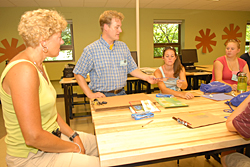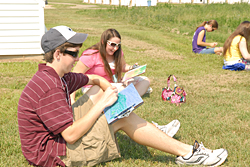
That was the message of “The Nature of Design: Exploring Art in the Landscape,” a weekend camp for high school students sponsored by UD's Department of Plant and Soil Sciences.
Held in early August, the camp attracted nine students from Delaware, Pennsylvania, Maryland and Connecticut. They spent their nights at the Courtyard Newark-University of Delaware and their busy days at the UD Botanical Gardens, UD Farm, Longwood Gardens, White Clay Creek State Park, Brandywine Park, Gibraltar and other area parks and gardens.
“Landscape design is a true blend of art and science,” Susan Barton, instructor of plant and soil sciences and Cooperative Extension specialist in ornamental horticulture, said. “It's a field that cultivates creativity. Landscape designers shape, color and conserve the environment around them.”
In recent years, Barton has reached out to high school art teachers to spread the word about the artistic aspects of landscape design. But this is the first time the landscape design program held a camp focused on students with artistic talent.
Barton said she would like more high school students to consider landscape design as a college major, in part because there are more job openings than there are qualified designers.
“There is a critical demand for landscape designers,” Barton said. “This is a high-paying profession with great career opportunities. We want artistic students, especially those who are passionate about the environment, to see that landscape design can be a fulfilling outlet for their interests.”
The camp was organized and led by Barton and Jules Bruck and Chad Nelson, who both are assistant professors of landscape design. “We wanted to expose the campers to as much learning as possible during a 36-hour timeframe,” Barton said.
“Students had a lot of time to work on their drawing and presentation skills in the studio,” Nelson said. “But we also made sure that they got to see real landscapes, where they could get personal experience with issues including invasive plants as well as seasonal change and interest.”
When the students arrived on the UD campus Aug. 3, they immediately set to work on a sketching exercise that focused on form and color. Then they set out on a walking tour of UD's campus, which features the landscape design of acclaimed 20th century designer Marian Coffin. The UD professors discussed the problem of invasive plants, after which the students went to White Clay Creek State Park in search of specific invasives. Unfortunately, they were all too easily found.From there, the students traveled to Longwood Gardens for a private tour, followed by a bit of volunteer work, during which they removed invasive seedlings from Longwood's Meadow.
Saturday featured a series of garden visits, ranging from the highly structured, formal “garden rooms” featured at UD's Goodstay Center to the informal design style seen on the grounds of the Delaware Center for Horticulture. By mid-afternoon, the students were back on UD's campus to work on their studio design project and prepare group presentations for their parents/guardians, showcasing all that they had learned.
“I learned a lot and I especially enjoyed the sketching exercise on Friday,” camper Samantha Hurst, a senior at Polytech High School said.
Kaila Tatman, a senior at Greenwood Mennonite School, has known for a long time that she wants to be landscape designer. She said her favorite part of the camp was helping design a landscape plan for a home garden.
She also found the invasive plant exercise to be a learning experience. “I was surprised how many species of invasive plants we found growing in the woods and even by the side of the road,” Tatman said.
“We found the students to be smart, interested and engaged in all of the planned activities,” Bruck said. “I was tremendously impressed with how they bonded as a group and how mature they acted during the entire weekend. I enjoyed the camp tremendously and look forward to running it again next year.”
Article by Margo McDonough
Photos by Danielle Quigley


